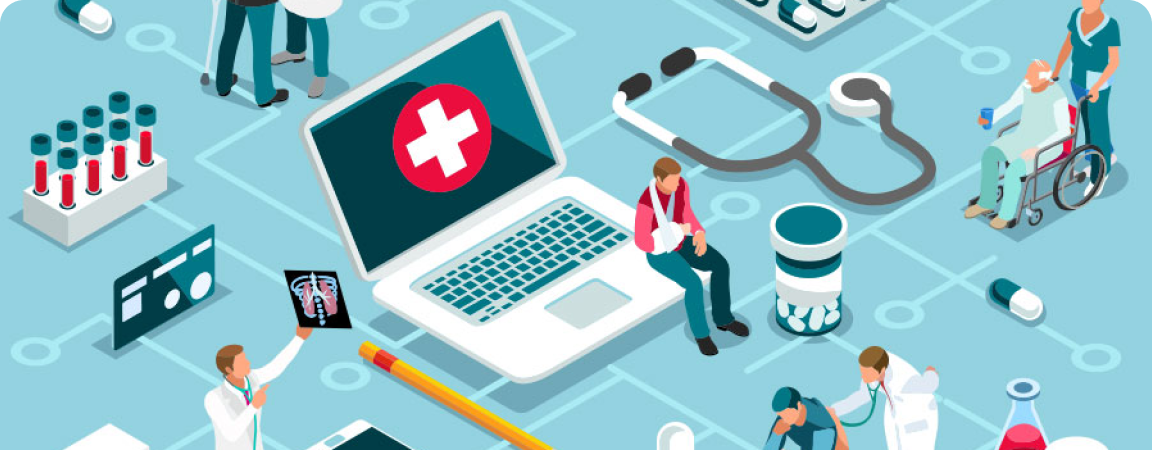November 23, 2021 | 12-minute read
Top 5 ways providers can save time before your patients even arrive

November 23, 2021 | 12-minute read

Productivity and efficiency are crucial for providers feeling the financial squeeze from COVID-19. Here’s how healthcare organizations can leverage patient-facing digital health technologies to maximize their resources.
From the biggest health systems to the smallest clinics, every healthcare organization includes countless moving parts. The interactions between patients, clinicians, the front office, and the back office must work in perfect harmony in order for the organization to deliver excellent care in an efficient and effective manner.
Unfortunately, too many providers are whittling away time and leaving money on the table with inefficient administrative processes that lead to worsening staffing shortages and ongoing COVID-19 bottlenecks.
With health systems losing more than $445 billion over the course of the pandemic, and physicians seeing an average 32 percent drop in revenue, organizations need to do something different to make up lost financial ground. At the same time, they have to continue to satisfy their patients.
One solution lies in rethinking the way patients flow through their entire patient journey. For example, instead of completing patient-intake activities at the time of the appointment, which can slow down the journey and introduce administrative errors and costly rework, organizations can harness digital health technologies to complete intake quickly — before the patient even arrives.
By empowering patients to use a comprehensive, integrated digital health platform to register and check-in prior to their appointment, healthcare organizations can reduce pressure on limited resources and create positive experiences for all.
In fact, in a single year, digital check-in alone can result in:
Here are five great tips for saving time with a digital workflow that begins before your patients even arrive.
Managing the daily schedule requires experience and patience in the best of times. Too often, when patients fail to show up, the entire system can quickly fall into chaos.
Providers can take a more proactive approach to scheduling by equipping patients with seamless digital tools allowing them to self-schedule at their own convenience. Patients can take the time to identify and select an appointment — at a time they know they can commit to — or quickly reschedule through their smartphone without requiring any of your staff’s valuable time.
Online self-scheduling will reduce no-shows, keep the calendar moving, and give administrative staff more time to focus on other tasks. A digital health platform can also offer sophisticated schedule management that allows your enterprise to allocate patients to certain locations or certain clinicians automatically to manage the flow without a single click or phone call.
Many consults and procedures require patients to take specific actions beforehand, whether it’s fasting, arranging a ride home, or bringing certain information along to the appointment. If patients fail to follow prep instructions, the visit may have to be rescheduled, which results in lost revenue and delayed care.
With a digital health platform that is deeply integrated into the EHR, providers can automatically send appropriate pre-visit instructions via the patient’s communication pathway of choice, ensuring that the information gets where it needs to go in a timely manner. By making certain that patients are informed in advance, staff members can prevent potentially costly and disruptive events on the day of the appointment.
Duplicate medical records resulting from incorrect and out-of-date demographic information is a leading cause of medical errors. Additionally, straightening out duplicate or improperly merged records can cost thousands of dollars per patient. Providers can reduce these costs by giving patients the opportunity to input their most current information before ever reaching the care site.
Using a digital health platform to collect and verify demographic and insurance information prior to the visit gives patients the opportunity to keep their data up to date. In a time when masks and plexiglass barriers can easily lead to data entry mistakes, pre-visit data verification is essential for avoiding confusion and streamlining check-in.
It’s also a great way to avoid hundreds of thousands of data-entry clicks for your staff. When patients input information on an integrated platform, the data is automatically captured — no rekeying required! Your staff will never have to squint at illegible patient handwriting again. Plus, you’ll save plenty of time and money by avoiding paper documents and all those hours wrestling with the copy machine.
Safety is paramount in the age of COVID-19. Digital check-in capabilities allow patients to avoid standing face-to-face with front desk staff for longer than necessary, reducing exposure for both the patient and the employee. Patients can even use digital tools to check in remotely from the parking lot and wait for permission to enter the building, allowing providers to control the number of people in any given space.
Since patients have completed their pre-visit paperwork at home, this process takes a fraction of the typical time, freeing up staff members to attend to other issues and dramatically improving the patient experience.
There’s an additional benefit of transitioning to a digital-first patient journey. When patients use their own smartphones, tablets, or home computers to interact with their providers, healthcare organizations can save significantly on patient-facing technology costs.
Providers may wish to have a small number of tablets or workstations available for patients who do not complete their intake tasks at home, but the majority of individuals are likely to use their own devices to communicate with their care teams. Avoiding the use of high-touch items like clipboards and pens is also a great safety measure that reduces time your staff might spend on cleaning.
Encourage patients to take charge of their own health with simple, intuitive, and user-friendly digital tools. Your patients and your staff will benefit from time saved and a better experience overall before the patient even steps through the door.
The Qure4u complete digital health platform is the best way to automate administrative tasks and effortlessly develop satisfying relationships with your patients. How much could your organization save?
Qure4u Inc. 2024